Jovian Planets, What are they?
Our solar system is made up of eight planets, all orbiting the Sun which is the biggest star in this system. These planets, each possessing its own unique characteristics, and there are some characteristics that are similar to their neighbouring planets that can lead to a specific kind of classification or grouping. In my previous post, I wrote about such grouping where the first four planets are termed terrestrial planets. Today, we will be talking about the other of such grouping in the universe known as the Jovian Planets.
Simply put, Jovian planets are gas giants named after Jupiter, the largest of the bunch. They are the next four planets after Mars, and they include Jupiter, Saturn, Uranus, and Neptune. The origin of the word Jovian stems from Jove which is a substitute name for the Roman god known as Jupiter. All four planets orbit from quite a distance from the Sun, and they are much larger than their terrestrial planets counterparts.
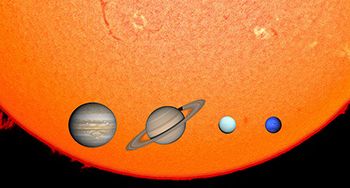
Gas giants and the Sunby Sun Image under the Creative Commons Attribution-Share Alike 4.0 International license.
Also, their structural composition is quite different, a simple example is that unlike the rocky planets, the Jovian planets don’t possess a solid surface.
The Jovian Planets
Although they possess certain similarities, the Jovian planets also vary in several characteristics, which includes; mass, size and composition. Officially known as the gas giants, and giant planet, they are primarily made up of hydrogen and helium gas, as well as other heavier elements. Also known to have a large system of moons (we will discuss this in future posts), as well as possessing their ring systems.
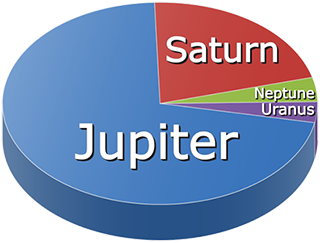
Masses of gas giants by Kwami under the Creative Commons Attribution-Share Alike 3.0 Unported license.
Although Jovian planets are also known as giant planet or gas giants, astronomers tend to use the term “gas giant” to describe only Saturn and Jupiter, while they term Uranus and Neptune as “Ice giants” - the reason is that of their composition. This name allocation is often misleading as all four giant or Jovian planets are primarily composed of fluids that are above critical point, that possess a non-existent gaseous or liquid phase.
Hydrogen and helium are the principal components in Jupiter and Saturn, while in Uranus and Neptune comprises of ammonia, water and methane.
Major Structural Composition
They possess a dense molten core composed of rocky elements, there is the possibility that this core in its entirety may have been dispersed and dissolved all around the planet if the heat of the planet is hot enough. Giant planet is usually enormous in size, and are known to possess a thick atmosphere composed of hydrogen and helium. Traditional gas giants planets like Saturn and Jupiter have helium and hydrogen as the major constituents of its mass, whereas these elements only make up an outer envelope for Neptune and Uranus. Instead, they are basically composed of ammonia, water and methane, that’s why they are known as “ice giants”
The most detectable exoplanets are those that orbit in close proximity to their stars, they are often known as Extrasolar giant planets. Often referred to as hot Neptunes and hot Jupiter due to their extreme surface temperatures. Before the use of telescopes that are space-borne, hot Jupiters were the most prevalent known forms of exoplanets, and this is as a result of how easy it is to detect with the use of ground-based instruments.
MEET THE JOVIAN PLANETS
So far we have explored some of the similarities these planets share, as well as a few difference in their composition. We know about the “gas giants” which are Jupiter and Saturn and we also know about “Ice Giants” which are Neptune and Uranus. Some other nuances these planets also share is that despite how similar the weather patterns, composition, structures and atmosphere condition is; there is a slight difference. The major difference is that atmosphere gets progressively colder, the further it gets away from the Sun. This has resulted in making each of the Jovian planets, having its cloud of distinct layers whose altitudes are controlled by their temperatures, resulting such gases to condense into a solid and liquid state.
JUPITER
The Fifth planet in the solar system, Jupiter is so massive that it is 2 and half times bigger than the whole planets in our solar system combined. It is primarily made of gases, hence it getting names a gas giant. The fourth brightest solar body in our solar system after the Sun, Moon and Venus, it is so bright that it is visible to the unaided eye when looked at from Earth.
First sighted by the ancient Babylonians in the 7th century Bc. It got its name from the king of the Roman gods. It represents the god of thunder - Zeus in Greek mythology. It has the shortest days in our solar system, a day on Jupiter is equivalent to 9 hours, 55 Minutes in Earth’s time. It takes approximately 12 Earth years to complete a full orbit around the Sun. Possessing the Great Red Spot, which is about 350 years old, the size is so enormous that it can contain 3 Earths inside. Its core is made of metal, rocks and hydrogen compounds, and its moon Ganymede is the largest moon in the solar system.
Jupiter has a thin ring system, which is mainly composed of dust particles which must have been displaced as a result of comets and asteroids impact.
SATURN
It is the farthest planet in the solar system that is observable with the naked eye, the second biggest planet after Jupiter, and the sixth planet away from the Sun. Saturn is famous for its amazing ring system, which observed first by Galileo Galilei an astronomer in 1610. This gas giant primarily consists of gases such as Helium, Methane and Hydrogen. Named after the Roman god called Saturnus, the Greeks knew the planet as Cronus. A day on Saturn lasts for 10 hours, 34 minutes in Earth’s time, making its day the second shortest in the solar system, after it gas giant colleague - Jupiter.
It earned the nickname “Lubadsagush” meaning “oldest of the old” in ancient Assyrian tongue, this is because it takes Saturn 29.4 Earth years to orbit the Sun. The topmost layer of its atmosphere is partitioned into strips of clouds, ammonia ice is found on the top layers, while beneath the topmost layer, you find clouds of water. Then at the lower layers, sulfur ice mixture and cold hydrogen are predominant here. The planet is primarily made of hydrogen which is found in levels of dense hydrogen, and at the core of the planet, this hydrogen becomes metallic.
Known to possess about 150 moons, the largest which are Rhea and Titan, while Enceladus seems to harbour an ocean beneath its surface of the ice. Saturn possesses extensive rings which are made of chunks carbonaceous dust and ice.
NEPTUNE
The last of the known planets in our solar system, as its position is 8th after the Sun, it is the third biggest planet in terms of mass. Named after a Roman sea god, which is as a result of its bluish colouration. And the Greek know it as the god of the sea aka Poseidon. The planet was initially called “Le Verrier” named after the discoverer Joseph Le Verrier, however, the name was quickly abandoned and Neptune was adopted.
It takes 164.8 Earth years for Neptune to orbit the Sun, and on the 11th of July 2011, it completed its first orbit since the planet’s discovery. The planet’s largest moon Triton was discovered 17 days after the planet was discovered. The planet has the second largest gravity in the solar system, second to Jupiter. It takes Neptune approximately 18 hours to spin on its axis, and this is due to the fact that the planet lacks a solid body.
With an average surface temperature of -214oC, Neptune has an active climatic condition wherein the upper levels of the atmosphere experience massive storms with speed up to 1,340 km/h per second. The planet has 14 discovered moons, the largest of this bunch being Titan, often described as a frozen world that emits dust, ice and nitrogen particles from beneath its surface.
URANUS
The seventh planet in the solar system, visible with the naked eye but due to its slow orbit dimness in appearance made it quite difficult to be identified as a planet, It is the first planet to be discovered with the aid of a telescope. Uranus rotates in a retrograde fashion, contrary to the fashion the Earth and a host of planet rotates. A day on Uranus is about 17 hours 14 minutes in earth time. It completes its orbit around the Sun in 84 years.
Known as a one of the “Ice giant” planets, it possesses a hydrogen and helium upper layer, and beneath it is the Icy mantle which is engulfed with ice core and rocks. The planets distinctive colour of a weird shade of blue is, as a result, the upper atmosphere is made of methane, water and ammonia.
Known to have the nearly coldest temperatures in the solar system, temperatures in its atmosphere can get to -224oC. The planet has 2 sets of dark thin coloured rings, these ring particles are quite little, which ranges from a dust size particle to little boulders. There are two outer rings and eleven inner rings.
References
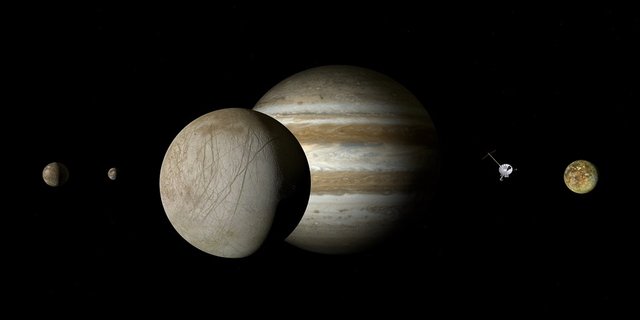
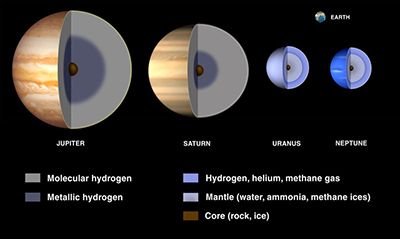
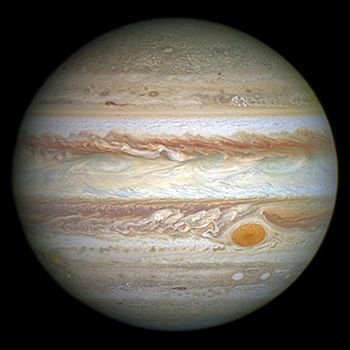
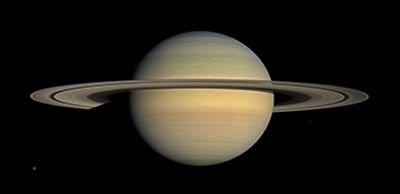
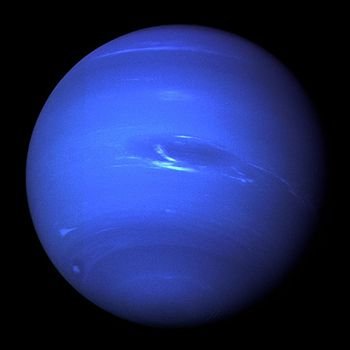
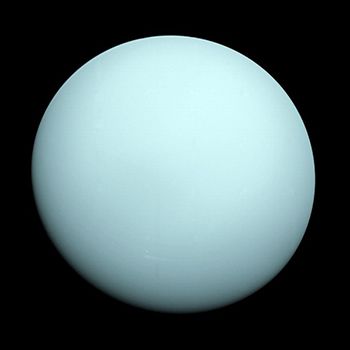
Thanks man for a quick rewind of astronomy lesson. I didn't know these planets are known as Jovian!
Cheers!
Many thanks for checking out my post
Wow, it was first, the Terrestrial planets, now its the Jovian planets..I guess High school Geography wasn't meant to treat this because I'm just hearing them for the first time...
Thanks for the exposure buddy
You're welcome, I am just glad you took out time to read it.
It looked new and I wanted to learn...Plus your simplicity and clear words made it enjoyable
Keep steeming!
Many thanks bro...
respect